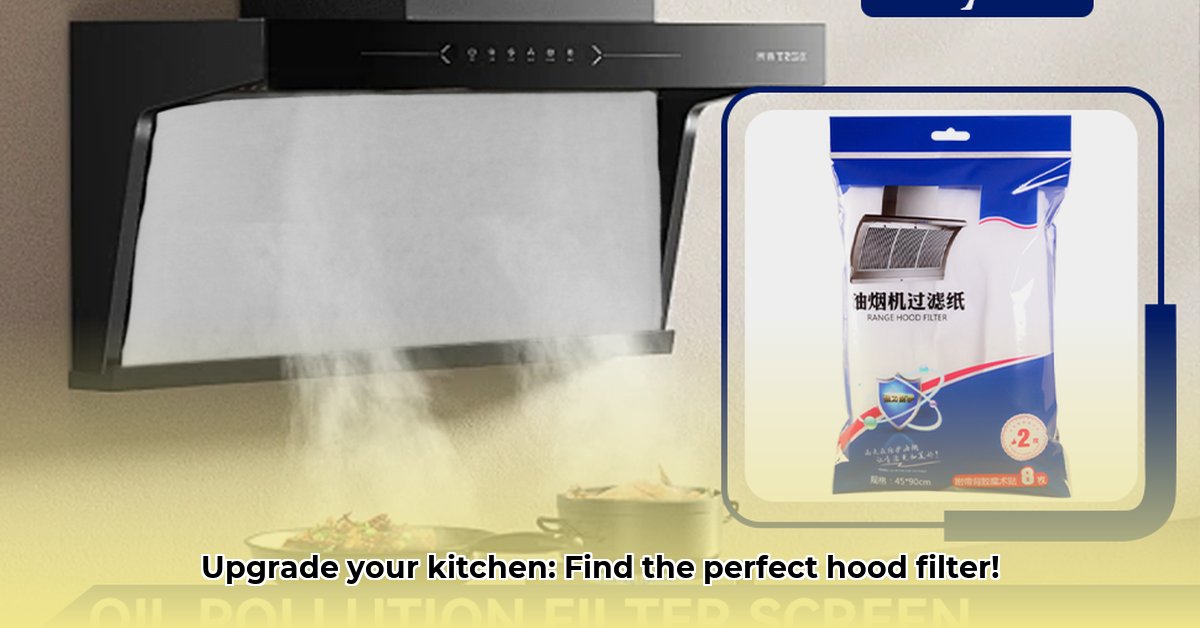Is your kitchen plagued by lingering odors and greasy surfaces? The solution might be simpler than you think: your range hood filters! These unsung heroes work tirelessly to keep your kitchen air clean and fresh, but choosing the right one can be confusing. This comprehensive guide will demystify range hood filters, walking you through everything from understanding different types to mastering maintenance. Say goodbye to kitchen chaos and hello to a clean, safe, and enjoyable cooking space!
Understanding Range Hood Filters: Your First Line of Defense Against Kitchen Messes
Range hood filters are essential for maintaining a clean, healthy, and enjoyable cooking environment. They trap grease, smoke, and odors produced during cooking, preventing them from circulating throughout your home. Choosing the right filter can feel overwhelming, but with a little knowledge, you can find the perfect match for your needs. This guide is designed to empower you with the information you need to make the best choice for your kitchen.
Assessing Your Cooking Needs: A Key Step in Filter Selection
Before diving into the world of range hood filters, take a moment to assess your cooking habits. Are you a passionate home chef who frequently fries, sears, and sautés? Or do you primarily prepare light meals and snacks? Your cooking style plays a significant role in determining the type of filter you need and how often it should be cleaned or replaced. Understanding your cooking intensity helps you select the optimal filter for your kitchen.
Consider these factors:
- Frequency of Cooking: How often do you cook each week?
- Type of Cooking: Do you frequently cook with high heat and oil, creating a lot of grease and smoke?
- Cooking Volume: Do you typically prepare large meals or smaller portions?
The more frequently you cook and the more grease and smoke you generate, the more robust your range hood filter needs to be.
Ducted vs. Ductless: Understanding Your Range Hood Type
Range hoods come in two primary types: ducted and ductless. Knowing which type you have is crucial for selecting the appropriate filter. The type of range hood you have dictates the type of filter you need.
- Ducted Range Hoods: These hoods vent air outside your home through ductwork. They excel at removing grease, smoke, and odors, but may require less frequent filter cleaning. They primarily rely on metal filters to trap grease.
- Ductless Range Hoods: Also known as recirculating hoods, these filter air and recirculate it back into your kitchen. They’re ideal for apartments or homes without ductwork, but require filters that can effectively remove odors. They rely on a combination of metal and charcoal filters.
Exploring Range Hood Filter Types: Choosing the Right One for Air Quality
Now that you understand your cooking needs and range hood type, let’s explore the different types of filters available:
| Filter Type | Pros | Cons | Typical Replacement/Cleaning Frequency | Best For |
|---|---|---|---|---|
| Aluminum Mesh | Inexpensive, durable, easy to clean (often dishwasher safe), effectively traps grease, washable, widely available | Requires regular cleaning to prevent grease buildup, may not be as effective at removing odors as other filter types | Every 1-3 months | Ducted range hoods, general grease filtration, light to moderate cooking |
| Stainless Steel | Very durable, easy to clean, dishwasher safe, resists high heat and corrosion, long-lasting | More expensive than aluminum mesh, can be prone to scratches | Every 1-3 months | Ducted range hoods, heavy-duty grease filtration, high-heat cooking, professional kitchens |
| Plastic | Inexpensive, lightweight, easy to install | Less durable than metal, may warp or melt under extreme heat, not as effective at trapping grease | Every 1-2 months | Light cooking, temporary solutions, situations where budget is the primary concern |
| Charcoal/Carbon | Absorbs odors effectively, essential for ductless hoods, improves air quality in the kitchen | Not washable, needs replacing regularly, can be more costly in the long run, does not trap grease | Every 3-6 months, depending on usage | Ductless range hoods, odor removal, kitchens without external ventilation |
| Baffle | Excellent grease capture, durable, easy to clean, often found in commercial kitchens, minimizes fire hazards | Can be more expensive than mesh filters, may not be suitable for all range hood models | Every 1-3 months | Heavy-duty cooking, high-grease environments, ducted range hoods, commercial kitchens |
| Plasma⁺ (Advanced Systems) | Extremely effective at removing odors, smoke, and other pollutants; long-lasting and requires minimal maintenance; environmentally friendly. | Higher initial cost; may not be compatible with all range hood models. | Varies | Any cooking style. Especially suitable for those concerned about maintenance and air quality. People with asthma or allergies. |
Important Note: Always measure your existing filter before purchasing a replacement to ensure a proper fit. Improperly sized filters can lead to reduced performance and potential damage to your range hood. Accurate measurements and consulting your range hood’s manual are crucial.
Maintaining Your Range Hood Filters: A Simple Guide for Optimal Performance
Regular maintenance is essential for keeping your range hood filters working effectively and preventing fire hazards. A clean filter also extends the lifespan of your range hood and improves its overall performance.
Here’s a simple cleaning and maintenance routine:
- Regular Inspection: Inspect your filter at least once a month. Look for excessive grease buildup, discoloration, or lingering odors. Adjust the inspection frequency based on your cooking habits. How often should you inspect your range hood filter for optimal performance and maintaining air quality?
- Cleaning Metal Filters: Most aluminum and stainless steel filters are dishwasher-safe, making cleaning easy. If you prefer handwashing, soak the filter in hot, soapy water for 15-20 minutes, then scrub with a brush. Rinse thoroughly and allow to dry completely before reinstalling.
- Replacing Charcoal Filters: Charcoal filters cannot be cleaned and must be replaced when they become saturated with odors. A good indicator is when you notice lingering cooking smells in your kitchen after running the range hood. How often to replace carbon filters hinges on cooking habits
- Plasma⁺ Filter Cleaning: Clean the outer surface of the unit occasionally to maintain its performance.
Making the Right Choice: Key Considerations Before You Buy Your First Filter
Selecting the right range hood filter involves carefully considering your needs and preferences. Ask yourself these questions to narrow down your options: Answering these questions simplifies your selection process
- Range Hood Type: Do you have a ducted or ductless range hood? This will significantly impact your filter selection.
- Filter Dimensions: Accurately measure your current filter to ensure a perfect fit.
- Cooking Style: How often do you cook, and what types of food do you prepare? This will determine the type of filter you need and how often it should be cleaned or replaced.
- Budget: Consider both the initial cost of the filter and the ongoing maintenance costs (cleaning supplies or replacement filters).
- Environmental Impact: Reusable metal filters are a more sustainable option than disposable charcoal filters. Consider the environmental impact of your choice.
- Maintenance Preferences: How much time and effort are you willing to invest in cleaning and maintaining your filters?
Choosing the right range hood filter is crucial for maintaining a clean, safe, and healthy kitchen. By understanding your needs and the different types of filters available, you can make an informed decision that will improve your cooking experience.
Choosing the Right Range Hood Filter
Finding the perfect range hood filter hinges on your unique cooking style, the type of ventilation system you have (ducted or ductless), and how much effort you’re willing to put into maintenance. It should align with your ventilation system, cooking habits, and willingness to maintain it.
Assessing Your Cooking Style: A Personalized Approach to Ventilation
Before exploring filter types, take a moment to honestly assess your cooking style. Are you someone who primarily reheats leftovers, or do you regularly tackle complex recipes involving frying, searing, and simmering? Understanding your cooking style is the critical first step. Heavy cooking generates more grease and odors, requiring a more robust filter.
Range Hood Filter Types: Effective Filtration on a Filter Comparison Chart
Here’s a detailed comparison table showcasing the strengths and weaknesses of each filter type:
| Filter Type | Pros | Cons | Best Suited For |
|---|---|---|---|
| Baffle | Exceptional grease capture, durable and reusable, easy to clean (often dishwasher safe), reduces fire hazards, ideal for high-volume cooking, professional |
- Glass Backsplash: Ideas For a Stylish Kitchen Update - December 2, 2025
- Glass On Tile: A Stylish Kitchen Backsplash Option - December 1, 2025
- Glass Tiles for Kitchen: Style and Durability Tips - November 30, 2025










